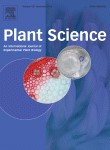Ver ítem
- xmlui.general.dspace_homeCentros e Institutos de InvestigaciónCIAP. Centro de Investigaciones AgropecuariasInstituto de Fisiología y Recursos Genéticos VegetalesArtículos científicosxmlui.ArtifactBrowser.ItemViewer.trail
- Inicio
- Centros e Institutos de Investigación
- CIAP. Centro de Investigaciones Agropecuarias
- Instituto de Fisiología y Recursos Genéticos Vegetales
- Artículos científicos
- Ver ítem
The chlorotic symptom induced by Sunflower chlorotic mottle virus is associated with changes in redox-related gene expression and metabolites
Resumen
Systemic infections are commonly associated with changes in host metabolism and gene expression. Sunflower chlorotic mottle virus (SuCMoV) causes systemic infection with sugar increase, photoinhibition and increase in antioxidant enzyme activities before chlorotic symptom appearance in sunflower leaves. The aim of this study was to determine if chlorotic symptom development induced by SuCMoV infection is accompanied by changes in different redox-related
[ver mas...]
Systemic infections are commonly associated with changes in host metabolism and gene expression. Sunflower chlorotic mottle virus (SuCMoV) causes systemic infection with sugar increase, photoinhibition and increase in antioxidant enzyme activities before chlorotic symptom appearance in sunflower leaves. The aim of this study was to determine if chlorotic symptom development induced by SuCMoV infection is accompanied by changes in different redox-related metabolites and transcripts. Symptom development was analyzed in the second pair of leaves (systemic infection) at different post-inoculation times: before symptom appearance (BS, 4 dpi), and at an early (ES, 7 dpi) and later stage (LS, 12 dpi) of symptom expression. The results showed that the virus reaches the second pair of leaves at 4 dpi. A positive correlation between chlorotic symptom and number of viral copies was also observed. Changes in hydrogen peroxide, glutathione, pyridine nucleotides and ATP content were observed since symptom appearance (ES, 7 dpi). The expression of some of the genes analyzed was also strongly affected by SuCMoV infection. Specifically, down-regulation of both chloroplast-encoded genes and chloroplast-targeted genes: psbA, rbcS, Cu/Zn sod, Fe sod, phosphoglycolate phosphatase, psbO, psaH and fnr was present, whereas the expression of cytoplasmic-targeted genes, apx1, and Cu/Zn sod was up-regulated. Mitochondrial Mn sod decreased at BS stage and aox decreased only at ES stage. Peroxisomal catalase (cat-2) was lower at BS and LS stages. All these results suggest that SuCMoV infection induces progressive changes in determinants of redox homeostasis associated with chlorotic symptom development.
[Cerrar]

Fuente
Plant Science 196 : 107-116 (November 2012)
Fecha
2012-08-18
Editorial
Elsevier
ISSN
0168-9452
Formato
pdf
Tipo de documento
artículo
Palabras Claves
Derechos de acceso
Restringido
 Excepto donde se diga explicitamente, este item se publica bajo la siguiente descripción: Creative Commons Attribution-NonCommercial-ShareAlike 2.5 Unported (CC BY-NC-SA 2.5)
Excepto donde se diga explicitamente, este item se publica bajo la siguiente descripción: Creative Commons Attribution-NonCommercial-ShareAlike 2.5 Unported (CC BY-NC-SA 2.5)

